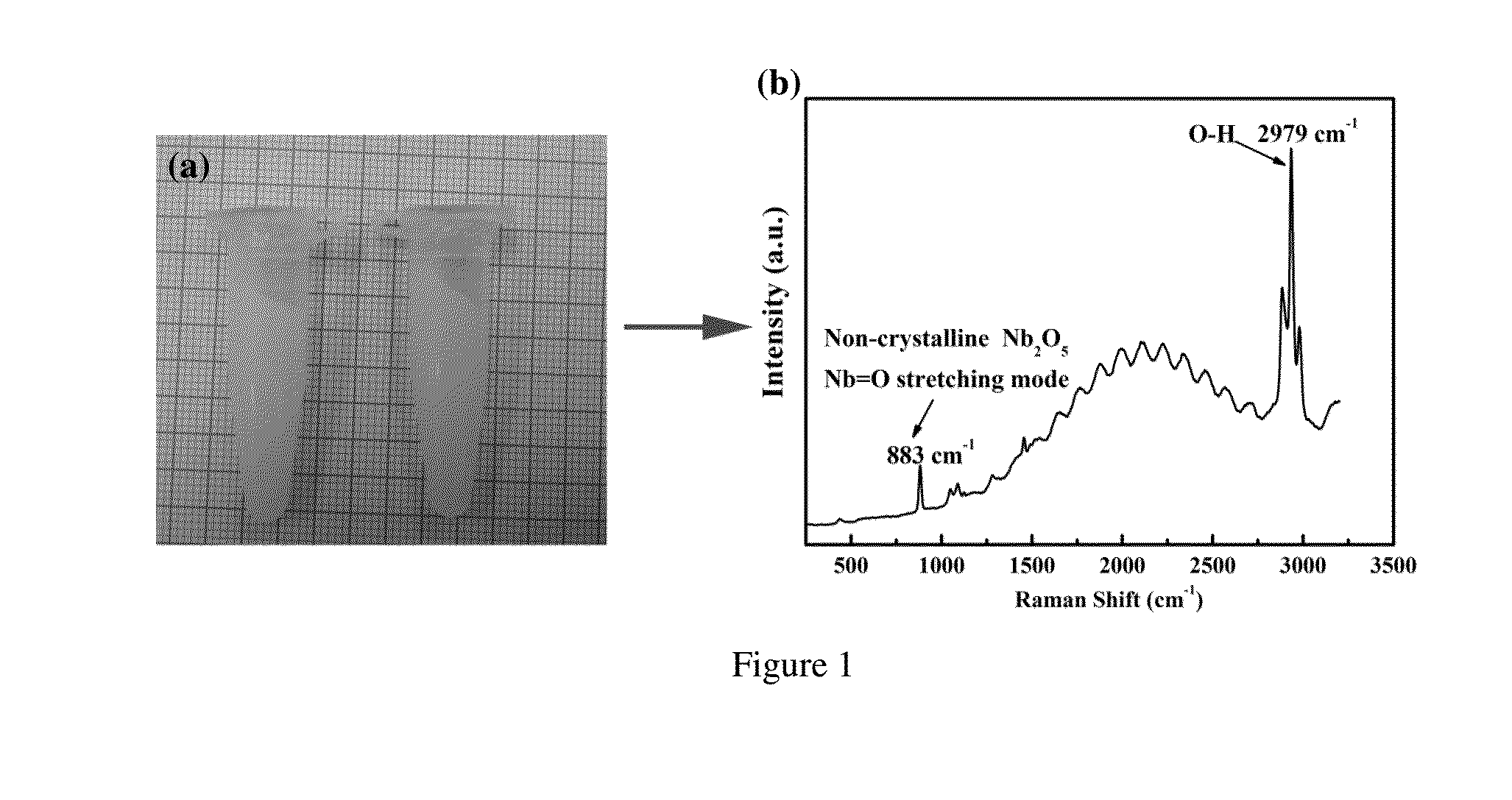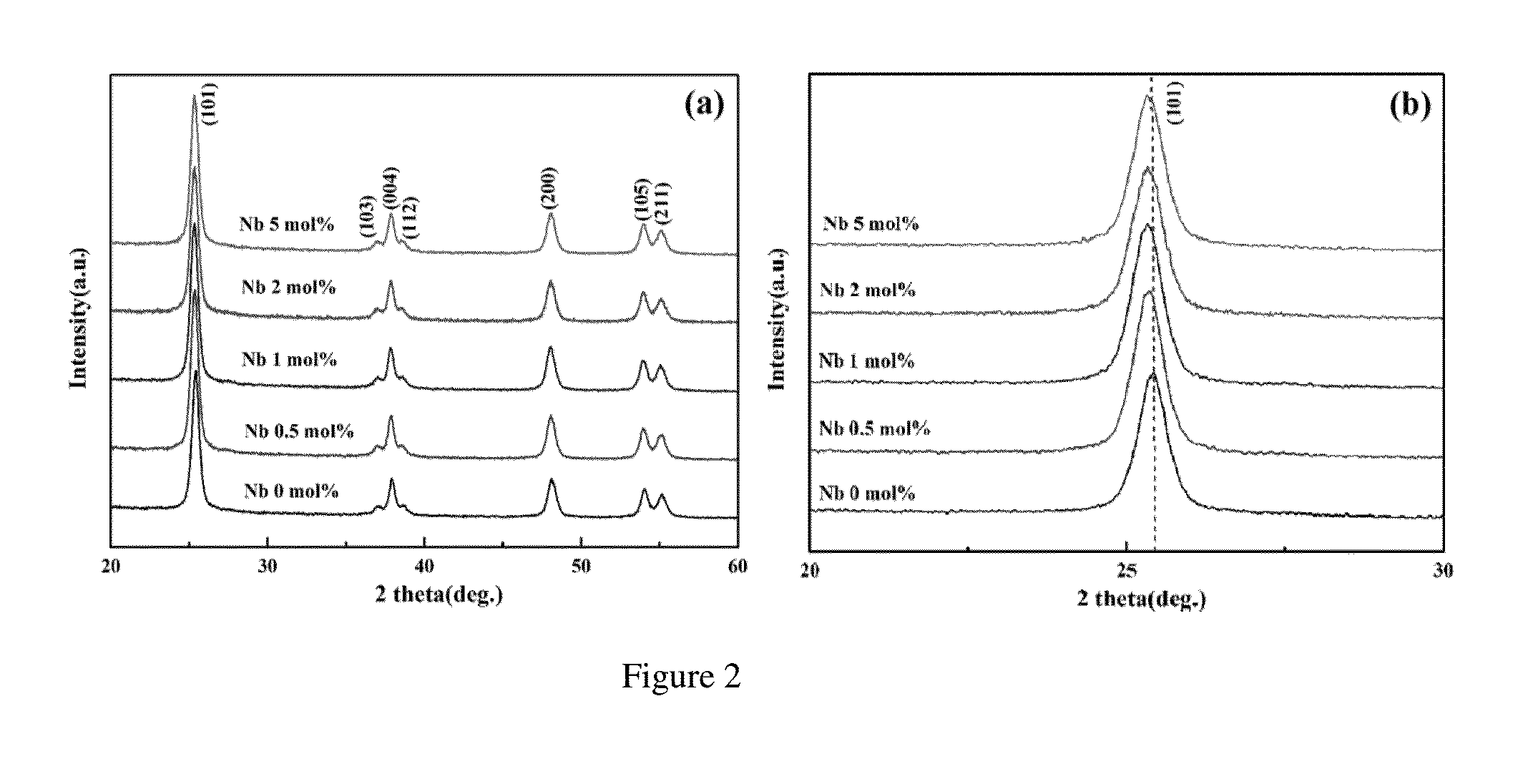One-pot synthesis of Nb2O5-doped TiO2 nanoparticles
a synthesis and nanoparticle technology, applied in the field of one-pot synthesis of nb2o5doped tio2 nanoparticles, can solve the problems of high preparation cost, low production efficiency, and high cost of synthesis of tio2 and precursors, and achieves high yield efficiency, low cost, and strong and broad light absorption
- Summary
- Abstract
- Description
- Claims
- Application Information
AI Technical Summary
Benefits of technology
Problems solved by technology
Method used
Image
Examples
example 1
One-Pot Preparation Of Nb-Doped Tio2 Nanoparticles
[0023]All chemical materials are purchased commercially, and used without further purification. Because the preparation process of TiO2 NPs have been mature at present, the commercial TiO2 slurry (Eternal Chemical Co. Ltd.) containing uniform NPs (concentration 18.6%) can be directly used as the starting base materials to provide the Ti source in the present invention, aiming to simplify the doping preparation process and improve the preparation efficiency. Niobium chloride (NbCl5) is used as the starting material to provide the Nb dopant source. The one-pot synthesis of Nb5+-doped TiO2 NPs is described as follows: 0.08 g NbCl5 (99%, Aldrich) powder is dissolved in 1.5 mL ethanol and then 1.5 mL deionized H2O is added and stirred to obtain a transparent precursor solution. After that, the transparent precursor solution is sequentially treated by the processes of UV irradiation for 20 min, high speed centrifugation (4000 rpm, 10 min),...
example 2
Fabrication of DSSCs
[0025]The fluorine-doped SnO2 conducting glasses (FTO, 10Ω / □, 3.1 mm thick, Nippon Sheet Glass) are ultrasonically cleaned in 4% glass cleaner (PK-LCG545, Parker) at 50° C. for 30 min, followed by rinsing with deionized water. To fabricate the photoanode, a two-film electrode is used. A first film which is a three-layer film of commercially available undoped TiO2 slurry is firstly coated onto the cleaned FTO glass by screen printing technique and then further coated by a second film which is a bi-layer film of the TiO2—Nb composite slurry prepared according to Example 1. The thickness of the obtained TiO2 bi-layer film is about 10 μm. The bi-layer film of the TiO2—Nb composite slurry coated on the three-layer film of commercially available undoped TiO2 slurry is then sintered at 450° C. for 30 min to remove the organics and then slowly cooled to room temperature to form a sintered photoanode. Subsequently, the sintered photoanode is immersed in a 0.4 mM N719 dye ...
example 3
Characterization Methods
[0026]The chemical structure of the gel is analyzed by Raman spectroscopy (inVia Reflex, Renishaw) with a laser wavelength of 514 nm. The crystal structure and phase identification of the prepared TiO2 NPs are performed by X-ray diffractometer (XRD, D8 Advance, Bruker). The morphology, size, crystallinity, and lattice structure of the NPs are investigated by field-emission transmission electron microscope (FE-TEM, Tecnai G2 F20 S-TWIN, FEI) as well as high resolution TEM (HRTEM). The binding state of chemical bond is studied by Raman spectra. The electronic structure and binding energy are determined by means of X-ray photoelectron spectroscopy (XPS, PHI-5400, PE). The surface morphology and microstructure of the TiO2 films are observed by scanning electron microscope (SEM, S-4800, Hitachi). The optical transmittance spectra of the films are performed by UV-vis spectrophotometer (HP 8453). The incident photon-to-current conversion efficiency (IPCE) spectra of...
PUM
| Property | Measurement | Unit |
|---|---|---|
| 2θ | aaaaa | aaaaa |
| wavelength range | aaaaa | aaaaa |
| transparent | aaaaa | aaaaa |
Abstract
Description
Claims
Application Information
 Login to View More
Login to View More - R&D
- Intellectual Property
- Life Sciences
- Materials
- Tech Scout
- Unparalleled Data Quality
- Higher Quality Content
- 60% Fewer Hallucinations
Browse by: Latest US Patents, China's latest patents, Technical Efficacy Thesaurus, Application Domain, Technology Topic, Popular Technical Reports.
© 2025 PatSnap. All rights reserved.Legal|Privacy policy|Modern Slavery Act Transparency Statement|Sitemap|About US| Contact US: help@patsnap.com



